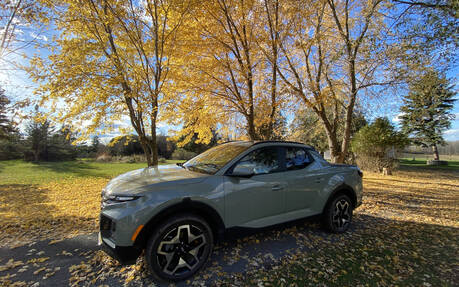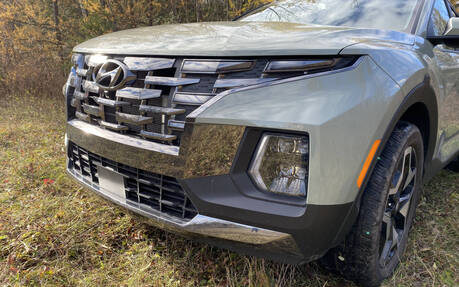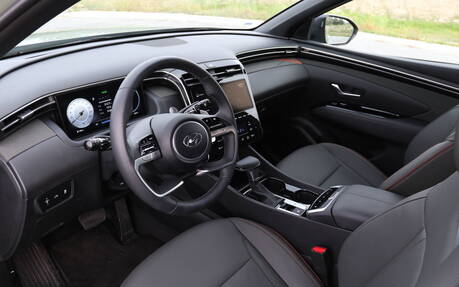2022 Hyundai Santa Cruz: How Sporty and Adventurous is it Really?
How does a manufacturer release an all-new car and already manage to be top of its vehicle class? Well, they create their own class segment of course. Enter the Hyundai Santa Cruz, the Korean automaker’s latest Sports Adventure Vehicle (SAV).
Now, this isn’t the first time we’ve seen the SAV acronym in the automotive world. BMW coined the SAV for Sports Activity Vehicle when they first launched the X6 years ago. And just like Hyundai with the Santa Cruz, BMW was able to claim they had the number one SAV … since it was the only one on the market, since they’d created the class.
- Also: 2022 Hyundai Santa Cruz: Play First, Work Later
- Also: 2022 Hyundai Santa Cruz: We Put Korea’s First-ever Pickup to the Test
We’re all for innovation and new things, but this idea that acronyms can prove the legitimacy of a vehicle seems a bit silly at times. So, instead of focusing on what Hyundai hoped the Santa Cruz to be, we instead looked at what it really was: something sandwiched between a big sedan and a crossover.

So, What is it Exactly?
To break it down technically, the Hyundai Santa Cruz is a glorified crossover since it is based on the Tucson platform. And while it has the body shape and style of a pickup truck, it’s clear that this will not be gaining any attention from would-be pickup buyers or those looking to change up their truck for something new and cool.
When we attempted to take the Santa Cruz to the end of a large field to deposit some stumps and old pumpkins after Halloween (have to feed the wildlife, after all!), it was a rather unnerving drive to the bottom of the field (one that had been handled quite well by other crossovers and SUVs over the previous months). It wasn’t that the Santa Cruz’s AWD wasn’t capable, but more about the ride height. Despite the surface not being hugely uneven, any divot or bump felt like a cavern. The large protruding transfer case hanging down in the middle didn’t help with the anxiety for the drive.

Now, of course, this is not branded as an off-road vehicle. Then again, Hyundai has branded it a sports ADVENTURE vehicle. So, wouldn’t an adventure include off-roading?
The overall impression we got from the Santa Cruz is that it’s somewhere between a car and an SUV, with a trunk that could potentially be more practical - but not all the time.
A Viable Pick-Up?
We realize we spent most of the week behind the wheel asking ourselves questions about the Santa Cruz. And here’s why: We weren’t quite sure what it was able to do well.
That shouldn’t be taken as a negative, it’s just that with a title like SAV, the body of a pickup, and the design of a sporty crossover (inside and out), we wanted to see where it really excelled amongst all of its mixed identities.

Truth be told, it is simply a crossover with an open trunk. We all know that the beauty with crossovers is that they drive like cars. Well, the same can be said for the Santa Cruz. It is light, nimble, decent on gas, and outfitted with the HTRAC all-wheel drive system.
While the Santa Cruz offers a bed, it’s not exactly the most practical size. With only 4ft of length in the bed and just slightly more on top - because you can carry up to 220lbs on top of the hard aluminum-lined tonneau cover - the pick-up-ness of the Santa Cruz is rather lost on this diminutive cargo space.
Using this vehicle as a traditional pick-up would not be the best choice, which is why those in the market for a working truck won’t ever look to Hyundai, unfortunately. Especially with the likes of the Ford Maverick hitting the market as a much more trucky truck that also starts around $10k cheaper than the Santa Cruz.

Really the Holy Cross-over?
The meaning of Santa Cruz is actually Holy Cross. While we are sure Hyundai didn’t have a religious reference in mind, we do think they meant to refer to it being the best of all worlds rolled into one.
Where the Santa Cruz does excel and do well is in the drive. Equipped with a 2.5L turbocharged 4-cylinder engine it produces 281 horsepower and 311 lb-ft of torque. Power is controlled via an 8-speed automatic transmission. Power is decent and well-suited for the size of the Santa Cruz. There’s also the possibility of towing up to 5,000lbs.
Truthfully, the Santa Cruz drives very much like a car and it’s easy to forget that there is a truck bed attached to the back, which is a good thing.
Traditional Hyundai Inside and Out
The best part about the Santa Cruz is the interior up front. Super comfortable and well designed, the driver and passenger spaces are plenty roomy. The onboard entertainment system is a breeze to use and gorgeous to look at. However, the lack of buttons and knobs is aggravating and something I wished for all week. The constant finger-proding to turn the volume up and down or adjust fan speed for the heating got old, really quickly.

The absolute best part about the Santa Cruz is the exterior design. Hyundai really went above and beyond designing the latest vehicles across the board. Sporting the family-bred front grille, the Santa Cruz blends together traditional pickup lines with modern futuristic cues in all the right ways. Oh, and did I mention I love that mute, mint-green colour? It had me at moss green … And thankfully, there aren’t too many angles or shoulder lines thrown in for cool factor like a few other Hyundai models currently on the road (*cough*Elantra*cough*).
Being Different is OK
What it comes down to is this: The Hyundai Santa Cruz offers something new and exciting in an already inundated segment (crossover). Because, let’s be honest: This is not a pickup, and it will never be. But it can be a more efficient and practical crossover or a super cool El Camino-type car. And we’re here for it and totally support Hyundai’s efforts at offering up something cool and niche for future buyers.
| Test drive report | |
| Test model | 2022 Hyundai Santa Cruz |
|---|---|
| Trim level | Ultimate |
| Price range | $38,499 – $44,799 |
| Price as tested | 44 799 $ |
| Warranty (basic) | 5 years/100,000 km |
| Warranty (powertrain) | 5 years/100,000 km |
| Fuel economy (city/highway/observed) | 12,1 / 8,6 / 10,8 L/100km |
| Options | N/A |
| Competitive models | Ford Maverick, Honda Ridgeline |
| Strong points |
|
| Weak points |
|
| Editor's rating | |
| Fuel economy | Decent for a vehicle that sports a truck bed |
| Comfort | Up front is spacious and comfy, but things seem snug in the second row |
| Performance | Good amount of power and pickup |
| Infotainment | Hyundai's onboard system is one of the best in the automotive world these days |
| Driving | Super easy to drive in both urban and country settings |
| Overall | Hyundai has a niche product here suited to someone who's torn between a car and a crossover but wants to be different |